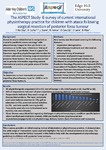QOL-05. E-SURVEY OF CURRENT INTERNATIONAL PHYSIOTHERAPY PRACTICE FOR CHILDREN WITH ATAXIA FOLLOWING SURGICAL RESECTION OF POSTERIOR FOSSA TUMOUR
| dc.contributor.author | Hartley, H | |
| dc.contributor.author | Carter, B | |
| dc.contributor.author | Bunn, Lisa | |
| dc.contributor.author | Kumar, R | |
| dc.contributor.author | Cassidy, E | |
| dc.contributor.author | Lane, S | |
| dc.contributor.author | Pizer, B | |
| dc.date.accessioned | 2018-07-09T11:18:47Z | |
| dc.date.issued | 2018-06-22 | |
| dc.identifier.issn | 1522-8517 | |
| dc.identifier.issn | 1523-5866 | |
| dc.identifier.uri | http://hdl.handle.net/10026.1/11822 | |
| dc.description.abstract |
Abstract OBJECTIVE To determine current international practice regarding physiotherapy input for children with posterior fossa tumours. METHODS An e-survey primarily composed of closed questions covering the following domains; participant demographics, treatment and intervention, virtual training, intensity/timing of treatment, aims and outcomes of physiotherapy was piloted and refined. It was distributed internationally to physiotherapists via 6 key groups; (Paediatric Oncology Physiotherapy Network (POPs), Association of Paediatric Chartered Physiotherapists (APCP), European Paediatric Neurology Society (EPNS), International Society of Paediatric Oncology (SIOP)-Europe Brain Tumour Group, Posterior fossa society (PFS), Pediatric Oncology Special Interest Group (American Physical Therapy Association). Data were analysed descriptively. RESULTS 84 physiotherapists participated: UK (n=53), rest of Europe (n=22), USA/Canada (n=9). The most common physiotherapy interventions used were balance exercises, proximal control activities, gait re-education, and task specific training. The most frequently used adjuncts to treatment were mobility aids and orthotics. A lack of clinical guidelines and research evidence in this area was highlighted. Frequent challenges raised regarding physiotherapy treatment in this area were; reduced availability of physiotherapy input following discharge from the acute setting, lack of evidence, impact of adjuvant treatment (e.g. chemotherapy/radiotherapy), and psychosocial impact. CONCLUSIONS This e-survey provides an initial scoping review of international physiotherapy practice in this area. It demonstrates the wide range of intervention types used and highlights the lack of clinical evidence in this area. The results raise the need for further research in this field to help with the development of physiotherapy guidelines in children with posterior fossa tumours. | |
| dc.format.extent | i158-i158 | |
| dc.format.medium | Undetermined | |
| dc.language.iso | en | |
| dc.publisher | Oxford University Press (OUP) | |
| dc.title | QOL-05. E-SURVEY OF CURRENT INTERNATIONAL PHYSIOTHERAPY PRACTICE FOR CHILDREN WITH ATAXIA FOLLOWING SURGICAL RESECTION OF POSTERIOR FOSSA TUMOUR | |
| dc.type | conference | |
| dc.type | Abstract | |
| plymouth.date-start | 2018-06-29 | |
| plymouth.date-finish | 2018-07-03 | |
| plymouth.issue | suppl_2 | |
| plymouth.volume | 20 | |
| plymouth.conference-name | International Symposium on Pediatric Neuro-Oncology | |
| plymouth.publication-status | Published | |
| plymouth.journal | June 2018Neuro-Oncology 20(suppl_2):i158-i158 DOI: 10.1093/neuonc/noy059.587 | |
| dc.identifier.doi | 10.1093/neuonc/noy059.587 | |
| plymouth.organisational-group | /Plymouth | |
| plymouth.organisational-group | /Plymouth/Faculty of Health | |
| plymouth.organisational-group | /Plymouth/REF 2021 Researchers by UoA | |
| plymouth.organisational-group | /Plymouth/REF 2021 Researchers by UoA/UoA03 Allied Health Professions, Dentistry, Nursing and Pharmacy | |
| plymouth.organisational-group | /Plymouth/Research Groups | |
| plymouth.organisational-group | /Plymouth/Research Groups/Institute of Health and Community | |
| plymouth.organisational-group | /Plymouth/Users by role | |
| plymouth.organisational-group | /Plymouth/Users by role/Academics | |
| dc.publisher.place | Denver, Colorado, USA | |
| dcterms.dateAccepted | 2018-05-15 | |
| dc.rights.embargodate | 2019-6-22 | |
| dc.identifier.eissn | 1523-5866 | |
| dc.rights.embargoperiod | No embargo | |
| rioxxterms.versionofrecord | 10.1093/neuonc/noy059.587 | |
| rioxxterms.licenseref.uri | http://www.rioxx.net/licenses/all-rights-reserved | |
| rioxxterms.licenseref.startdate | 2018-06-22 | |
| rioxxterms.type | Conference Paper/Proceeding/Abstract |


